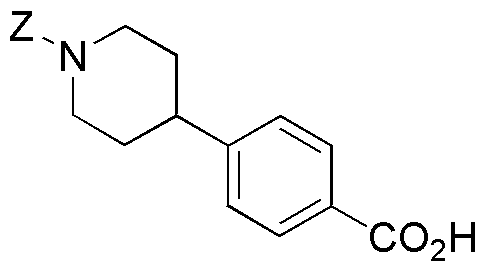Z-4-(4-carboxyphenyl)piperidine is widely utilized in research focused on:
- Pharmaceutical Development: This compound serves as a key intermediate in the synthesis of various pharmaceuticals, particularly in the development of analgesics and anti-inflammatory drugs.
- Biochemical Research: Researchers use it to study receptor interactions and enzyme inhibition, aiding in the understanding of complex biological processes.
- Material Science: It is applied in the creation of advanced materials, including polymers and coatings, due to its unique chemical properties that enhance material performance.
- Drug Delivery Systems: The compound is explored for its potential in formulating drug delivery systems that improve the bioavailability and targeted delivery of therapeutic agents.
- Analytical Chemistry: It is utilized as a standard in chromatographic techniques, helping in the accurate analysis of complex mixtures in various samples.
General Information
Properties
Safety and Regulations
Applications
Z-4-(4-carboxyphenyl)piperidine is widely utilized in research focused on:
- Pharmaceutical Development: This compound serves as a key intermediate in the synthesis of various pharmaceuticals, particularly in the development of analgesics and anti-inflammatory drugs.
- Biochemical Research: Researchers use it to study receptor interactions and enzyme inhibition, aiding in the understanding of complex biological processes.
- Material Science: It is applied in the creation of advanced materials, including polymers and coatings, due to its unique chemical properties that enhance material performance.
- Drug Delivery Systems: The compound is explored for its potential in formulating drug delivery systems that improve the bioavailability and targeted delivery of therapeutic agents.
- Analytical Chemistry: It is utilized as a standard in chromatographic techniques, helping in the accurate analysis of complex mixtures in various samples.
Documents
Safety Data Sheets (SDS)
The SDS provides comprehensive safety information on handling, storage, and disposal of the product.
Product Specification (PS)
The PS provides a comprehensive breakdown of the product’s properties, including chemical composition, physical state, purity, and storage requirements. It also details acceptable quality ranges and the product's intended applications.
Certificates of Analysis (COA)
Search for Certificates of Analysis (COA) by entering the products Lot Number. Lot and Batch Numbers can be found on a product’s label following the words ‘Lot’ or ‘Batch’.
*Catalog Number
*Lot Number
Certificates Of Origin (COO)
This COO confirms the country where the product was manufactured, and also details the materials and components used in it and whether it is derived from natural, synthetic, or other specific sources. This certificate may be required for customs, trade, and regulatory compliance.
*Catalog Number
*Lot Number
Safety Data Sheets (SDS)
The SDS provides comprehensive safety information on handling, storage, and disposal of the product.
DownloadProduct Specification (PS)
The PS provides a comprehensive breakdown of the product’s properties, including chemical composition, physical state, purity, and storage requirements. It also details acceptable quality ranges and the product's intended applications.
DownloadCertificates of Analysis (COA)
Search for Certificates of Analysis (COA) by entering the products Lot Number. Lot and Batch Numbers can be found on a product’s label following the words ‘Lot’ or ‘Batch’.
*Catalog Number
*Lot Number
Certificates Of Origin (COO)
This COO confirms the country where the product was manufactured, and also details the materials and components used in it and whether it is derived from natural, synthetic, or other specific sources. This certificate may be required for customs, trade, and regulatory compliance.


